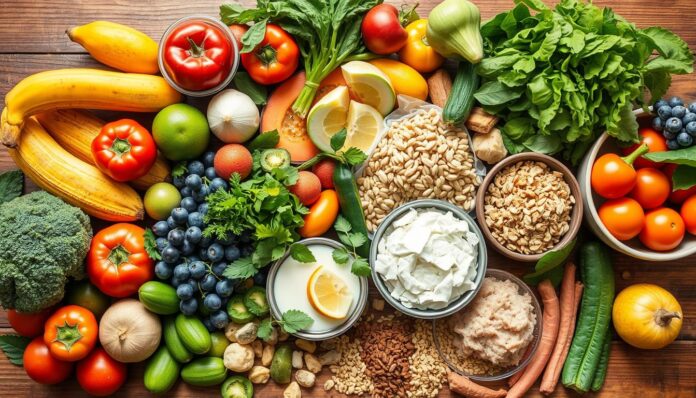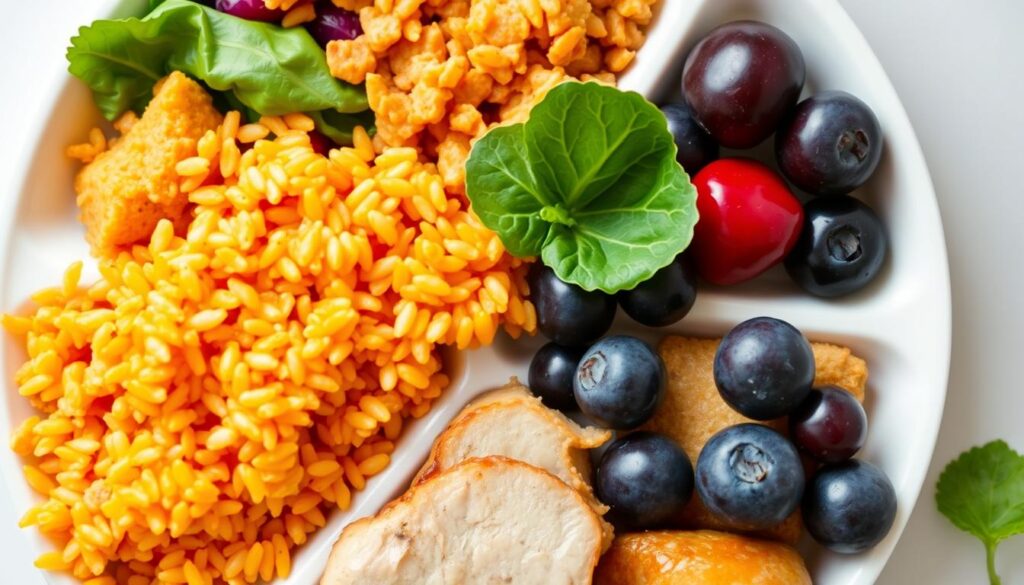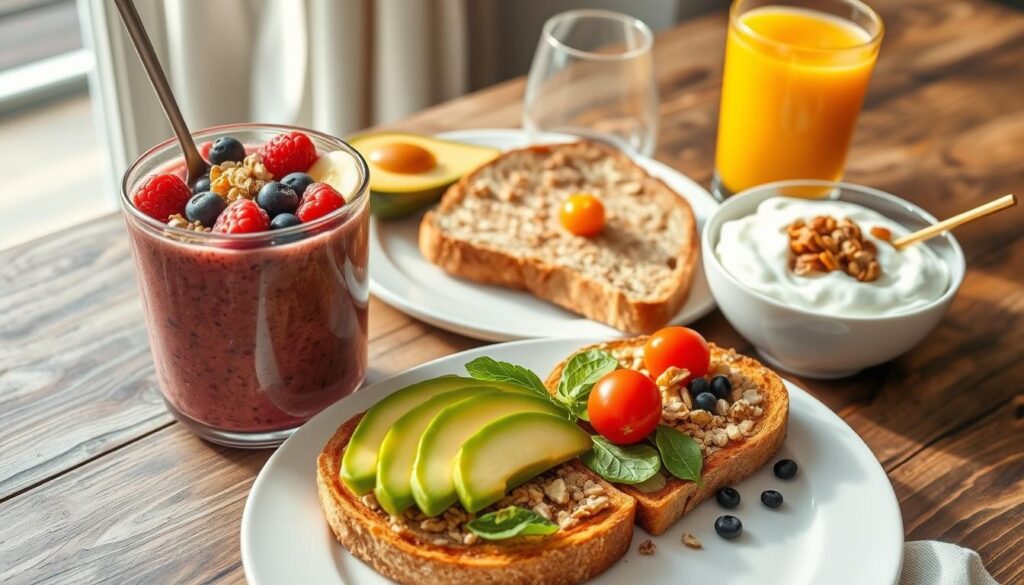Are you tired of feeling sluggish and struggling to maintain a balanced diet? Imagine a life where your energy levels soar, your mood improves, and your overall well-being is enhanced. The secret lies in cultivating healthy eating habits that can transform your lifestyle. In this guide, we’ll explore 10 essential habits for better nutrition, wellness, and a more vibrant you.
Key Takeaways
- Discover the fundamentals of balanced nutrition and the role of macronutrients in your diet.
- Learn the importance of incorporating essential vitamins and minerals for optimal health.
- Explore practical strategies for meal planning and grocery shopping to support your healthy eating goals.
- Understand the significance of hydration and making informed beverage choices.
- Develop mindful eating habits and learn to recognize hunger and fullness cues.
Understanding the Fundamentals of Balanced Nutrition
Keeping a healthy diet is key, more so as we get older. At the core of a good diet are proteins, carbohydrates, and fats. These nutrients give us energy, help our bodies work right, and keep us healthy.
The Role of Macronutrients in Your Diet
Proteins build our cells and muscles, helping them repair and stay strong. Carbs give us energy, and healthy fats are good for our brain and hormones. Finding the right mix of these is vital for a healthy diet.
Essential Vitamins and Minerals for Optimal Health
Vitamins and minerals are also vital for health. Calcium keeps our bones strong, and omega-3s are good for our heart and brain. Getting enough of these nutrients helps us stay healthy and feel our best.
Building a Healthy Plate Guide
The USDA’s “healthy plate” guide makes meal planning easy. It suggests half your plate for veggies and fruits, a quarter for whole grains or legumes, and a quarter for lean protein. This way, you get all the nutrients your body needs.
“Eating a balanced, nutrient-rich diet is essential for maintaining overall health and vitality as we age. By focusing on whole, minimally processed foods, we can ensure our bodies are getting the nourishment they need to thrive.”
Following these basic nutrition rules can make you feel great and keep you healthy for years to come. Small, steady changes can make a big difference in how you feel.
Start Your Day with a Nutrient-Rich Breakfast
Breakfast is key to starting your day right. It boosts your metabolism, sharpens your cognitive function, and helps you make better food choices. A good morning meal should mix protein, healthy fats, and complex carbs for lasting energy and nutrition.
If you’re in a rush, don’t skip breakfast. Opt for quick, healthy choices like a whole-grain bagel with peanut butter, fresh fruit, and 100% fruit juice. These are easy to keep in a dorm room or small kitchen, ensuring a great start to your day.
Studies show that a balanced breakfast can really boost metabolism and improve focus in school or work. Proteins keep you energized, while carbs from whole grains help control blood sugar and fight off tiredness.
| Breakfast Item | Nutrients | Benefits |
|---|---|---|
| Eggs and Toast | Protein, healthy fats, complex carbs | Promotes greater fullness and sustained energy |
| Greek Yogurt | Protein, probiotics | Satisfying and supports gut health |
| Cottage Cheese | Protein, calcium | Equally as satisfying as eggs |
| Nuts and Seeds | Healthy fats, fiber, antioxidants | May help reduce the risk of cardiovascular disease |
| Green Tea | Caffeine, L-theanine, EGCG | Boosts cognitive function and provides antioxidant protection |
Whether you like savory or sweet breakfasts, choose foods rich in nutrients. They fuel your body and mind in the morning. Starting with a nutrient-rich morning meal sets you up for a healthier, more energetic day.
Smart Meal Planning for Better Health
Smart meal planning can greatly improve your health and happiness. Planning meals and shopping for groceries can reduce stress and save money. It also helps you make healthier food choices. Let’s look at the key steps to successful meal planning for a better life.
Weekly Meal Prep Strategies
Begin by making a weekly meal plan that fits your diet and taste. Spend a few minutes each week to plan out healthy meals you can prep ahead. This saves time and ensures you have healthy food ready.
- Batch cook proteins, grains, and roasted vegetables to mix and match throughout the week.
- Prepare snacks like cut-up fruit, vegetable sticks, and hard-boiled eggs to have on hand.
- Freeze extra portions of meals for quick and easy reheating on busy days.
Grocery Shopping Tips
Shopping with a planned list can greatly improve your meal prep and organization. Stick to the store’s perimeter for fresh, whole foods. Avoid the aisles with processed and packaged items.
- Make a detailed grocery list based on your meal plan.
- Prioritize buying fruits, vegetables, lean proteins, and whole grains.
- Choose products with minimal added sugars and sodium based on nutritional labels.
Storage and Organization Methods
Good food storage and organization keep your ingredients fresh and reduce waste. Spend time prepping and storing your produce, dairy, and proteins. This makes it easy to assemble meals throughout the week.
| Food Item | Storage Method |
|---|---|
| Fruits and Vegetables | Store in airtight containers or resealable bags in the refrigerator. |
| Lean Proteins | Keep in the freezer in portion-sized containers or bags. |
| Grains and Starches | Store in airtight containers in a cool, dry place. |
By using these smart meal prep, grocery shopping, and food storage tips, you’re on your way to a healthier lifestyle. You’ll enjoy nutritious and satisfying meals.
Healthy Eating Habits for Sustainable Results
For lasting weight loss and better health, small, steady changes work better than big diet changes. Don’t try to cut out food completely, as it usually doesn’t work. Instead, add a few healthy habits that you can keep up with over time.
Begin with two or three new habits, like eating more whole, nutritious foods or watching your portion sizes. As you get better at these, you can add more healthy habits. It’s important to pick foods you like, so eating healthy is fun, not a burden.
Remember, lasting weight loss and better long-term health come from making lifestyle changes, not quick fixes. By building sustainable habits, you can reach your goals and keep them for years.
“Sustainable weight loss is not about deprivation, but about creating a balanced, enjoyable lifestyle that nourishes your body and mind.”
Take a holistic approach to your health, and you’ll be on your way to a happier, healthier life.
Mindful Eating and Portion Control
Adopting a mindful eating approach can change your life. It helps you listen to your body’s hunger and fullness signals. This way, you can control your food better and avoid eating too much without thinking.
Understanding portion sizes is key to mindful eating. It affects your health a lot.
Understanding Hunger and Fullness Cues
Your body takes about 20 minutes to know it’s full. Eating slowly and enjoying each bite helps you listen to your body. This way, you can stop eating when you’re full.
Mindful eating improves how you eat. It helps you eat slower, feel full sooner, and control your eating better.
Avoiding Distractions During Meals
Eating while watching screens or working can make you eat too much. Focus on eating to feel full. Studies show mindfulness helps reduce binge eating and eating because of emotions.
Eating with others makes meals more enjoyable. It slows you down and helps you connect with others. This is good for your health.
When eating out, watch your portion sizes, specially with foods high in calories. Ask about how food is made and ask for sauces on the side. Using a smaller plate makes food look bigger, helping you eat less.
Mindful eating and knowing the right portion sizes can improve your relationship with food. It helps you make choices that are good for you. You can eat well without feeling like you’re missing out.
Incorporating Whole Foods Into Your Diet
Adding whole foods to your diet is a great way to live healthier. Focus on eating a variety of fruits, vegetables, whole grains, and lean proteins. This will give your body the nutrients it needs. Try to eat foods of different colors to get a range of vitamins and minerals.
Choose whole-grain options like brown rice, oatmeal, and quinoa instead of refined grains. These foods are packed with fiber, which is good for your digestion and health. Add more vegetables to your meals, like spinach in eggs or roasted vegetables with your dinner.
| Whole-Food Swap | Nutrient Benefits |
|---|---|
| Brown rice instead of white rice | More fiber, magnesium, and B vitamins |
| Quinoa instead of couscous | Higher in protein, fiber, and minerals |
| Whole-wheat bread instead of white bread | Greater amounts of fiber, B vitamins, and antioxidants |
Eating more whole foods can greatly benefit your health. Studies show that diets full of whole foods can lower the risk of heart disease, cancer, and diabetes.
“Eating a whole-foods, plant-based diet has shown benefits such as weight loss, decreased cholesterol, decreased risk of cardiovascular events, and improved quality of life.”
Let whole foods be the base of your healthy diet. They will help you feel better and live a more vibrant life.
The Power of Hydration and Smart Beverage Choices
Staying hydrated is key for your health. Hydration helps control body temperature, keeps joints lubricated, and removes waste. Drink at least 8 glasses of water per day. You might need more if you’re active or in a hot place.
The amount of water you need changes based on your age, sex, and how active you are. Men should drink about 15.5 cups (3.7 liters) of water daily. Women should aim for 11.5 cups (2.7 liters). About 20% of your daily water comes from food, and 80% from drinks.
Alternatives to Sugary Drinks
Choose sugar-free beverages over sugary drinks. Here are some good options:
- Plain water (add lemon, lime, or fruit slices for flavor)
- Unsweetened sparkling water or seltzer
- Unsweetened coffee or tea
- Milk and milk alternatives (like almond, oat, or soy milk)
Watch out for drinks that seem healthy but have hidden sugars, like fruit punches and sports drinks. Diet sodas and drinks with artificial sweeteners might seem better, but their long-term effects are debated.
| Beverage | Calories | Sugar (g) | Artificial Sweeteners |
|---|---|---|---|
| Regular Soda (12 oz) | 140-170 | 39-46 | No |
| Diet Soda (12 oz) | 0 | 0 | Yes |
| 100% Fruit Juice (8 oz) | 110-150 | 26-36 | No |
| Unsweetened Seltzer (12 oz) | 0 | 0 | No |
Drinking enough water and choosing the right drinks can greatly improve your health. Focus on hydration and try different sugar-free beverages to keep your body and mind healthy.
Making Healthier Choices When Dining Out
Eating out can be fun, but it’s key to make smart choices for a healthy life. When you’re at a restaurant, pick meals that fit your diet and goals.
Begin by carefully looking over the menu. Ask your server about how dishes are made. This helps you find healthier options. Choose grilled, baked, or steamed foods over fried ones, which are often bad for you.
For protein, go for lean meats like chicken, turkey, or fish. Avoid processed meats like bacon and sausage. Add lots of fresh veggies to your meal to get more nutrients.
- Choose whole-grain foods like whole-wheat pasta or brown rice for more fiber.
- Add healthy fats from avocados, nuts, and olive oil for better health.
- Drink water, herbal tea, or sparkling water instead of sugary drinks or cocktails.
Even healthy-looking dishes can be high in calories. To control your portions, order a half-portion or share a meal with someone.
| Healthier Options | Less Healthy Options |
|---|---|
| Grilled, baked, or steamed dishes | Fried or breaded foods |
| Lean proteins (chicken, turkey, fish) | Processed meats (bacon, sausage) |
| Whole-grain options (whole-wheat pasta, brown rice) | Refined grains (white bread, white rice) |
| Vegetables and salads | French fries or chips |
| Water, herbal tea, or sparkling water | Sugary beverages or high-calorie cocktails |
By choosing wisely, you can enjoy eating out and stay healthy. Restaurants usually can make changes to fit your diet. So, ask for what you need.
“Healthy eating at restaurants starts with making informed choices, not just going with the flow.”
Understanding Food Labels and Processing
Exploring packaged foods can seem overwhelming. But, learning to read nutrition labels is essential for making smart, healthy choices. Look closely at the ingredient list. It often shows hidden sugars and sodium in foods like pasta sauce and cereals.
Hidden Sugars and Sodium
Processed foods often have too much added sugar and sodium. These can harm your health if you eat too much. Watch for terms like “high fructose corn syrup,” “sucrose,” and “maltose” on labels. Also, be wary of sodium-heavy ingredients like “monosodium glutamate” (MSG), “sodium nitrite,” and “sodium benzoate.”
Choosing whole foods over processed ones is better for your health. This way, you avoid too much sugar and sodium.
Identifying Healthy Packaged Foods
Some packaged foods can make cooking and meal prep easier. Look for frozen veggies, canned beans without salt, and other minimally processed items. When picking packaged foods, check the Nutrition Facts label.
Choose products with simple, easy-to-understand ingredient lists. Avoid foods with bisphenol A (BPA), found in some canned goods. Instead, go for glass containers or aseptic packaging.
FAQ
What are the key macronutrients and their roles in the body?
The main macronutrients are proteins, carbohydrates, and fats. Proteins help build and repair tissues. Carbohydrates give us energy. Fats support hormone production and cell function.
What are some essential vitamins and minerals needed for optimal health?
Key vitamins and minerals include vitamin C, vitamin D, calcium, iron, and magnesium. They boost the immune system, support bone health, and overall wellbeing.
What is the USDA’s "healthy plate" recommendation?
The USDA suggests filling half your plate with veggies. One-quarter should be whole grains or legumes. The last quarter is for lean protein.
Why is breakfast an important meal?
Breakfast boosts your metabolism and improves brain function. It helps you make better food choices all day. Include protein, healthy fats, and complex carbs in your breakfast.
How can meal planning help promote healthier eating?
Meal planning reduces stress and saves time. It encourages healthier choices. Plan your meals and shopping list for the week. Shop the store’s perimeter for fresh foods.
Why is it important to make sustainable changes instead of drastic diet overhauls?
Slow, sustainable changes stick longer than strict diets. Start with a few healthy habits. Gradually add more as you get better at them.
How can you practice mindful eating?
Mindful eating means listening to your hunger and fullness. Avoid distractions while eating. Be careful of portion sizes, even when eating out.
What are the benefits of incorporating a variety of whole foods into your diet?
Whole foods like fruits, veggies, grains, and lean proteins offer essential nutrients. Try to “eat the rainbow” for a variety of vitamins and minerals.
How much water should you aim to drink daily?
Drink at least eight glasses of water a day. More if you’re active. Replace sugary drinks with water, seltzer, and unsweetened coffee or tea.
How can you make healthier choices when dining out?
Be proactive about healthy choices when eating out. Ask about meal prep and make modifications if needed. Choose grilled, baked, or steamed foods over fried. Opt for dishes with lots of veggies and lean proteins.
How can you read and understand nutrition labels?
Nutrition labels help spot hidden sugar, sodium, and processed ingredients. Choose simple foods when you can. Look for frozen veggies and canned beans without added salt.






